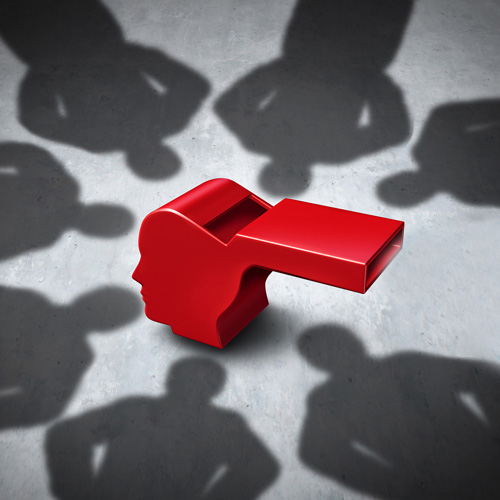Anonymous Reporting: Creating a Safe Harbor for Whistleblowers in the Workplace
Anonymous reporting systems play a pivotal role in maintaining organizational integrity by providing a secure avenue for employees to report misconduct.
From Mark Felt to Edward Snowden, stories of whistleblowers uncovering grand conspiracies, systemic abuse, and widespread corruption have been a permanent fixture in news headlines for decades. But not every case is so dramatic — oftentimes, whistleblowing is as simple as a concerned employee sharing evidence of mismanagement or some other form of misconduct on a much smaller scale.
While their stories are perhaps less splashy than those high-profile examples, these whistleblowers still play a vital role in maintaining the integrity of your business and deserve to be protected when they come forward. It’s imperative to establish an anonymous reporting channel for that purpose.
What is Anonymous Reporting?
Anonymous reporting is a structural process within organizational compliance frameworks that empowers individuals to report unethical behavior, misconduct, or regulatory violations without revealing their identity. This system is designed to protect the confidentiality of the reporter, thereby encouraging individuals to come forward with information they might otherwise withhold for fear of retaliation or reprisal.
Anonymous Reporting vs. Confidential Reporting: Key Distinctions
Though both are critical components of a company’s compliance framework and encourage whistleblowers to come forward, anonymous reporting and confidential reporting differ in how they protect the identity of the reporter and manage the information disclosed.
Where anonymous reporting enables individuals to report concerns without providing any identifying information, confidential reporting requires whistleblowers to disclose their identity to the organization or an intermediary. This disclosure comes with the assurance that their identity will be kept confidential and revealed solely on a need-to-know basis.
Anonymous reporting and confidential reporting come with respective benefits and drawbacks. The anonymity of the former fosters a sense of security among potential whistleblowers, as it eliminates the fear of exposure and retaliation. This can be an effective way to elicit critical information that reporters might otherwise withhold due to concerns over personal or professional repercussions. The latter, however, is helpful in situations where the context of the report requires further clarification or follow-up with the reporter to effectively address the issue.
Is Anonymous Reporting Legal?
Anonymous reporting — also known as anonymous whistleblowing — is generally legal and recognized as an important tool for promoting ethical business practices and regulatory compliance. Many jurisdictions, including the United States and the European Union, not only permit but encourage the use of anonymous reporting channels to protect whistleblowers and empower them to report misconduct without the risk of retaliation.
What is a Reporting Channel?
Broadly speaking, a reporting channel refers to any mechanism by which an employee, stakeholder, or external party can communicate concerns, share observations, or provide feedback to an organization. Reporting channels play an important role in governance, risk management, and compliance, enabling organizations to field and address issues that could impact their operations, reputation, or legal standing.
Reporting channels can take various forms, including:
- Hotlines: Telephone lines dedicated to receiving reports on issues such as fraud, safety concerns, ethical violations, and so on. Hotlines can be managed internally or by a third-party provider.
- Online portals: Web-based platforms that enable individuals to submit reports electronically. Organizations can often customize these portals to include forms, document upload capabilities, and automated workflows for handling reports.
- Email systems: Email addresses designated for receiving reports. While straightforward to implement, these require robust data management practices to ensure confidentiality and proper information handling.
- In-person reporting: Direct communication with designated personnel, such as HR representatives, compliance officers, or supervisors. This method relies on personal interactions and may include formal interviews or informal conversations.
- Suggestion boxes: Physical or electronic boxes where individuals can leave anonymous or signed reports. These are a common feature in environments where digital access is limited.
With notable exceptions — particularly, in-person reporting — almost any reporting channel can be anonymized. For example, organizations can outsource their hotlines to third-party providers that do not trace calls or record callers’ identifying information. Online platforms can be customized to allow for anonymous report submission, with encryption and other security measures in place to further protect whistleblowers’ identities.
The Incentives For Setting Up An Anonymous Reporting Channel
An anonymous reporting channel is a critical step for organizations committed to maintaining high ethical standards and fostering a culture of integrity. This secure mechanism empowers employees to report concerns without fear, guaranteeing that vital information reaches those in a position to address it.
By implementing an anonymous reporting channel within your organization, you can:
- Reduce the risk of reprisal or retaliation, encouraging whistleblowers to come forward. Fears of personal or professional repercussions can be a deterrent for potential whistleblowers. By providing individuals a way to share their concerns without revealing their identity, your organization can create a safe space for employees to disclose sensitive information.
- Gain access to important information you otherwise wouldn’t. Employees are often privy to misconduct, fraud, safety violations, or other unethical behavior that management and leadership may not be aware of. Anonymous whistleblowing channels open a vital line of communication, providing those employees with a secure way to report such issues, enabling your organization to uncover and address problems before they escalate and protecting both company and stakeholder interests.
- Create an organizational culture of trust and transparency. Establishing an anonymous reporting channel signals a commitment to ethical practices. When employees see that they can report their concerns without any risk of repercussions, it builds trust in your organization’s leadership and processes. This trust fosters a culture where transparency is valued and ethical behavior is encouraged, leading to a more cohesive and motivated workforce.
- Make employees feel valued and heard. Supporting anonymous reporting demonstrates to employees that their voices matter, and that the organization is willing to listen to and act on their concerns. By empowering employees, you can make them feel more valued and respected — which can, in turn, increase overall job satisfaction and reduce turnover. When employees believe that their input can lead to positive change, they’re more likely to actively engage in your organization and contribute to its success.
- Create a more inclusive workplace. Members of marginalized groups have historically been less likely to report identity-based harassment or discrimination for fear of reprisal. These groups often face significant barriers to reporting, including concerns about not being believed or facing further discrimination. Implementing an anonymous reporting channel provides these individuals with a safe, secure way to voice their concerns, ensuring their experiences are acknowledged and taken seriously. By giving a voice to those who are often silenced, you can create a more inclusive and equitable working environment, where all employees — regardless of background — feel respected and supported.
- Avoid unwanted press or attention. Anonymous reporting channels enable organizations to manage and resolve issues internally before they attract external scrutiny or negative publicity, avoiding scandal and reputational damage. Taking a proactive approach to issue resolution not only protects your organization’s public image, but also reassures employees and stakeholders that issues are taken seriously and handled responsibly.
- Comply with whistleblowing legislation. Depending on your industry and where your company operates, you may be subject to whistleblowing legislation, such as the EU Whistleblower Directive or the Public Interest Disclosure Act. These laws mandate that organizations provide safe and confidential avenues for reporting misconduct. Compliance with these and other laws and regulations not only enables your company to avoid legal penalties but also demonstrates your commitment to upholding ethical standards.
- Encourage whistleblowers to come forward — in their own time. Many whistleblowers take time to come forward, often due to fear or uncertainty about the repercussions. Anonymity can reduce this barrier, enabling individuals to report issues when they feel safe and ready to do so. This flexibility prevents valuable information from being lost and empowers whistleblowers to share their concerns in a manner that respects their timing and circumstances.
How to Implement an Anonymous Reporting Channel in Your Company
- Identify the scope and purpose. Defining the scope and purpose of your anonymous whistleblowing channel is a foundational step to its implementation. Start by clarifying what your objectives are for this channel — is it to promote transparency? To prevent misconduct? Some combination of the two? Then, determine what types of issues it will address, such as fraud, harassment, discrimination, safety violations, and other ethical concerns. This level of clarity will ensure that employees understand what types of issues they can report and that your channel serves its intended function, promoting transparency and accountability throughout your organization.
- Choose the right platform. Which reporting platform you choose can spell the difference between a successful or unsuccessful anonymous whistleblowing program. Your chosen platform should specialize in anonymous reporting and offer robust security features to protect reporters’ identities. Look for a platform that provides encrypted communications and has secure data storage and a user-friendly interface.
A third-party managed solution can provide additional assurance of confidentiality and impartiality, increasing employees’ trust in the system. Be sure to evaluate various platforms based on their ability to meet these and other criteria and select the one that most closely aligns with your organization’s needs and resources. - Set up multiple reporting lines. To increase the likelihood of employees actually submitting reports, make anonymous reporting available across multiple channels. By providing a diverse array of reporting options, you ensure that all employees — regardless of their preferred communication method or access to technology — have a way to anonymously voice their concerns. When setting up reporting lines, consider including the following channels:
- Secure, web-based forms
- Dedicated phone line
- Physical drop box
- Mobile application
- Designated reporting email address
Be sure to integrate these various reporting lines, creating a centralized database to collect and manage reports from all channels.
- Develop a response protocol. Determining how your company will respond to incoming reports is one of the most important elements of implementing anonymous reporting. After all, the credibility of your entire reporting system hinges on your organization’s ability to handle reports promptly, thoroughly, and fairly.
With that in mind, you’ll need to create a response protocol that includes the following: - Promptly acknowledging the receipt of reports to reassure reporters that their concerns are taken seriously.
- Establishing a systematic approach for investigating reports that ensures impartiality, thoroughness, and confidentiality. This involves clearly defining steps for gathering facts, interviewing relevant parties, and documenting your findings.
- Communicating the outcomes of investigations to the affected parties. Not only does this demonstrate that your organization values and acts on the information provided, reinforcing the importance of the reporting channel, but it also underscores your company’s commitment to transparency.
- Collaborate with your legal and compliance teams. Working closely with your legal and compliance teams throughout this process will ensure that your reporting channels and response protocol comply with all applicable laws and regulations. This includes adherence to data protection laws, whistleblower protection laws, and industry-specific standards. Be sure to regularly review and update reporting procedures and your response protocol so that they reflect current requirements to protect both reporters and your organization.
- Train managers and HR personnel. Your HR and management teams will be responsible for overseeing your anonymous reporting program, so it’s vital that you provide them with comprehensive training on the correct procedure for managing and investigating reports. As part of this training, emphasize your organization’s commitment to protecting whistleblowers and fostering a culture of integrity.
- Promote the channel to your employees. Once live, broadcast the new anonymous reporting program to your employees through meetings, emails, and training sessions. For best results, it’s important that employees not only be aware of the different channels available to them, but also that they understand how to use each reporting method. Clear and consistent communication about the availability and importance of anonymous whistleblowing channels will help integrate it within your larger organizational culture.
- Establish a feedback loop and conduct regular audits. Implementing an anonymous reporting program isn’t a one-and-done project — it’s an ongoing effort that your organization must continuously improve over time. The key to achieving this is to solicit feedback from your employees using anonymous surveys or suggestion boxes; encourage them to be honest about their experience and to offer recommendations for improvement. Additionally, conduct regular audits to assess the performance of each channel, looking for areas for improvement so that the program continues to meet your organization’s and your employees’ needs.
Throughout every step of this process, fully commit to ensuring the anonymity of those who submit reports. Your reporting channels should be designed in such a way that they inherently protect the identity of reporters, making it impossible for their information to be traced or revealed. By emphasizing and upholding this commitment, you can build trust amongst your employees and build a culture of integrity and accountability.
10 Key Criteria To Look For In Anonymous Whistleblower Software
When implementing an anonymous reporting program within your organization, you can go one of three ways:
- You can try to manage the program internally using manual processes. What you’ll save on costs, you’ll make up for in complexity, as manual processes are often cumbersome, error-prone, and increase the risk of accidentally exposing whistleblowers’ identifying information.
- You could build your own custom reporting system. While perhaps more efficient than manually managing reporting, this will require significant IT and development resources to build, manage, and maintain — a tall order for any organization, and a major hurdle for smaller companies that may not have sufficient resources.
- You can invest in third-party reporting software. This is often preferable to building an in-house system from scratch, as you gain access to specialized expertise, robust security features, and regulatory compliance out of the box, enabling you to focus on what matters most — expediently addressing and resolving issues.
Should you choose to pursue option number 3, here are the key criteria to look for in athird-party anonymous incident reporting and management tool:
- Anonymity: It almost goes without saying, but the foremost criterion for any anonymous whistleblowing software is that it be able maintain the anonymity of reporters. The software should not request any identifying information from reporters, nor track their IP address. Additionally, the software should include access control measures to restrict access to sensitive data based on user roles and responsibilities, ensuring only authorized personnel can view or manage reports.
- Ease of use: Don’t let an overly complicated design discourage employees from reporting. Look for software that has a user-friendly interface and supports multiple reporting methods, including web forms, a mobile app, and a phone hotline, to accommodate reporters with different preferences and technical capabilities.
- Customizability: No two organizations are alike, so why should their anonymous reporting software be? The right software should allow you to tailor reporting forms to collect the specific information you require, as well as create custom workflows for incident management and response protocols. By setting up customized workflows, you can streamline internal processes, ensuring that reports are handled efficiently and in accordance with established procedure.
- Single source of truth: Your platform of choice should provide a centralized repository where you can securely store all related case information and investigation details. This single source of truth will ensure that all relevant data is easily accessible and can be managed from a single interface, making investigations more efficient and reducing the risk of information being lost or overlooked. It also enables seamless collaboration between compliance teams, investigators, and other stakeholders involved in the resolution process.
- Reporting and analytics: Robust reporting and analytics capabilities are key to monitoring how effective your reporting system really is and identifying trends within reporting data. Your anonymous whistleblowing platform should offer real-time access to submitted reports and status updates to authorized personnel, enabling them to closely track the progress of ongoing investigations. Additionally, analytics tools can generate actionable insights to help you identify recurring issues or potential risks. You’ll also want to look for a platform that includes benchmarking features, which enable you to compare your organization’s performance against others in your industry; this can provide valuable context into your organization’s compliance and ethical performance.
- Compliance: The importance of proper compliance can’t be overstated, which is why you’ll want to look for an anonymous reporting platform built with regulatory guidelines and industry standards in mind. But compliance goes beyond the software itself — it’s also important to choose a software provider with a global presence and a strong understanding of laws and regulations within your jurisdiction.
- Integration: Any anonymous reporting system you implement should be compatible and able to seamlessly integrate with your existing HR, compliance, and case management systems. Integrating your HR and reporting systems allows for more efficient tracking of employee-related issues, enabling you to quickly identify and resolve patterns in misconduct. Integration with compliance systems ensures reports are automatically documented and managed within your existing regulatory framework, simplifying audits and reducing your risk of non-compliance. Finally, connecting your anonymous reporting software to your case management system guarantees that reports are swiftly moved into investigation workflows to support the consistent, thorough, and coordinated handling of cases across the organization.
- Support and training: Reliable customer support from your third-party provider is critical to the success of your anonymous reporting program. Look for vendors that offer comprehensive training materials for both end-users and administrators, ensuring all stakeholders throughout the reporting process are fully equipped to use the system. Global support and translation services are a key consideration for multinational companies so that employees in different regions who speak different languages can use the system with confidence.
- Security: Given the sensitive data contained within anonymous reporting systems, your software provider should hold relevant security certifications and regularly update the system to address emerging security vulnerabilities and compliance requirements. These strong security measures maintain the integrity of the system and the confidentiality of the reports within it, preventing unauthorized access and data breaches.
- Vendor reputation: The reputation of your anonymous reporting platform is only as good as that of the vendor behind it. When evaluating potential solutions and providers, prioritize choosing a vendor with a strong track record in the compliance industry, supported by positive references and case studies from other organizations that have successfully implemented their software.
How Anonymous Reporting Builds A Stronger Company Culture
With both regulatory and public scrutiny at all-time high, organizations are under significant pressure to maintain the highest of ethical standards and operate with integrity. In this environment, anonymous reporting channels are no longer just an option — they’re a necessity. By providing your employees with a safe way to voice their concerns without fear or risk of reprisal, you not only protect your organization from potential pitfalls but also build a culture of trust and accountability. However, the success of your anonymous reporting program depends heavily on the tools you choose.
StarCompliance’s Incident Management & Whistleblowing Solutions are designed to help organizations such as yours meet these challenges head-on. With a comprehensive feature set that guarantees anonymity, streamlines incident management, and integrates seamlessly with your existing systems, our solutions empower you to resolve issues promptly and maintain regulatory compliance. Our success stories, including our work with Honda and a major U.S. airline, demonstrate the transformative impact our tools can have on enhancing corporate integrity.
Discover how StarCompliance can support your organization in building a stronger, more ethical workplace. With our solutions, you can ensure that every voice is heard, and every issue addressed. Schedule your free demo today.

The 7 Deadly Sins of Whistleblowing



